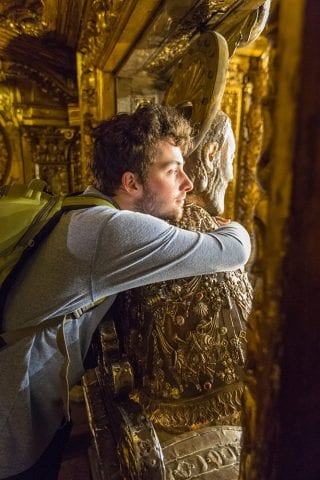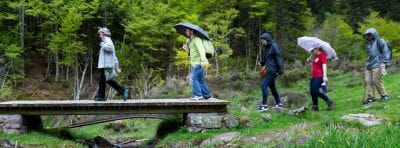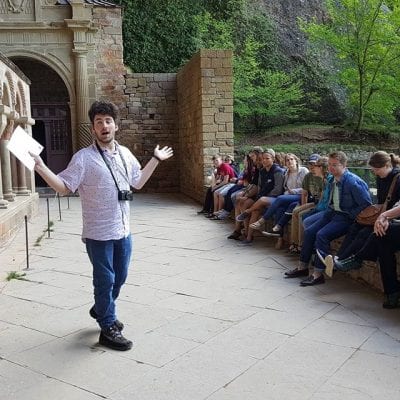
Samuel Lipson hugs the gilded statue of St. James at Santiago de Compostela, a ritual for pilgrims ending their journey along the Camino de Santiago. Photo: Russell Cothren.
After a few relatively sleepy centuries, the number of pilgrims following the Camino de Santiago has exploded, from 2,905 in 1987 to more than 300,000 in 2017. Today, hundreds of thousands of Christian pilgrims have embraced this medieval ritual, trekking and biking across rugged terrain in France and northern Spain to the cathedral in Santiago, where St. James’ remains are said to rest. Why are these 21st-century pilgrims putting their lives on hold to follow the Camino? In this post Samuel Lipson, an information systems/management double major, Bodenhamer Fellow, and Eagle Scout explores some of his own reasons for joining the Honors Passport: Pilgrimage course and shares some of the challenges he faced – and met.
I live for “different.” Oftentimes, I feel like my life is overly routine, and I take every opportunity I feasibly can to do something out of the ordinary. So, for those of you who are wondering what reason a business student of minimum spirituality would have to go on the Camino de Santiago pilgrimage, I saw in it a way to marvel at the boundless creativity brought on by religious devotion. Furthermore, I wanted to challenge my body (already disabled with mild cerebral palsy) to walk the same strenuous path of millions before me. With that in mind, allow me to share with you three of the most outlandish and extraordinary experiences of the past two weeks.
Have you ever heard of a town called Conques? I don’t wrong you if you haven’t; it’s a small commune of not even 100 residents about three hours out from any large cities. I wish I could recreate the feeling of walking into town as we disembarked the bus. “Magical” might seem like an absurd description, but it’s truly the only word I can think that even begins to do the view of Conques justice. With its picturesque cobblestone pathways, the moss growing through crevices in buildings, and goats continuously bleating in the background, I half-expected an armor-clad knight to come gallivanting down the streets as he continued his quest for some mystical object.
At the center of Conques stood our destination—the imposing Romanesque Abbey Church of St. Foy, named after an adolescent martyr put to death for shunning pagan gods. Unlike the many other churches we visited during our journey, in St. Foy we were allowed to access the upper levels. Exploring the higher section of the church and its decorative capitals magnified the grandiose nature of the building’s construction; it felt like I was hovering in an ethereal dreamland. Surprisingly, my experience there would become even more meaningful as we went to the nearby cloister. After learning about the church’s portal and reliquary from fellow students, I decided to spend some of my free time meditating in the walkways of the monastery. I’m not a particularly spiritual person, and usually, meditation is simply a means of stress relief for me. However, something about the rolling hills and valleys surrounding me punctuated by the setting sun in the distance produced what I can only explain as a transient state of being. I wonder if that’s part of the reason medieval pilgrims favored this site, and Conques in general—did it have as much emotional sway over them as it did me? I resolved to repeat the process in every other cloister we visited.

“Be Prepared” — Sam Lipson, second from left, had an umbrella handy when the skies opened during a hike in the Pyrenees. Photo: Russell Cothren.
Three days later, after staying in Toulouse, it was time for the peak of our team’s physical activities—the hike through the Pyrenees. Hiking was nothing new to me; as a Boy Scout, traversing mountains is practically a rite of passage. However, as I stared down the both literally and metaphorically significant climb ahead, I was heavily reminded of the 20-mile hike around Lake Fayetteville I had undertaken as the final task on my path to the Eagle Scout award over two years ago. Regardless, it still surprised me how quickly my initial burst of energy dissipated through a combination of thin air, steep paths, and an absurd downpour. It wasn’t long before my body was soaked from falling into a brook and my legs felt strained from wearing the wrong kind of shoes. I don’t know why, but as we made the final ascent, I started screaming with wild abandon. In hindsight, I can’t explain why I did that; it was practically an involuntary reaction. As I sat in the bus at Somport Peak, I began to wonder if my exhaustion was part of what drove the influx of pilgrims in recent years—do people seek out the physical challenge as much as they do the spiritual journey? It was something I pondered as we moved on to Spain.

Samuel Lipson presents at a spectacular site — San Juan de la Peña, a monastery built into a cliff. The cloister shown here dates to ca. 1190. Photo courtesy Sam Lipson.
“Sam, we’re almost here.”
What?! I had been so busy trying to memorize the details of my presentation that I had nearly forgotten to watch as we approached my site: San Juan de la Peña. I was ready to engage with everyone in the monastery, but I deliberately avoided looking at pictures so that my first time seeing it would be in person. Even the road our bus took seemed to imbue a sense of discovery; as we entered the ruins over the top of a hill, it felt like we had stumbled upon some lost secret of a forgotten age. The architecture of San Juan amplifies this feeling even more; it was literally carved into the cliff face that hangs above it, and it now seemed as if the earth had grown over it after centuries of neglect.
It might seem strange that such a massive monastery be built in such an inhospitable location, but there was a twofold purpose for doing so. The oldest part of the building sits above the grave of a saintly hermit, thus imbuing San Juan with holy significance. However, the reason it grew to its full size was through the patronage of the Aragonese king. At the time, San Juan sat on the border of Aragon and its Muslim enemies, and the king encouraged the growth of the monastery as a symbol of both his authority and Christian superiority. As I sat in the cloister meditating after detailing this information to my compatriots, I thought about how lucky I was to take part in in the Pilgrimage—both the study abroad program and the Camino itself. I realized then that this feeling is what drove the architects of the Camino: the desire to create a spiritual experience that simultaneously documented the geopolitical circumstances of the time, in a fashion that could be meaningful almost a millennium later.

